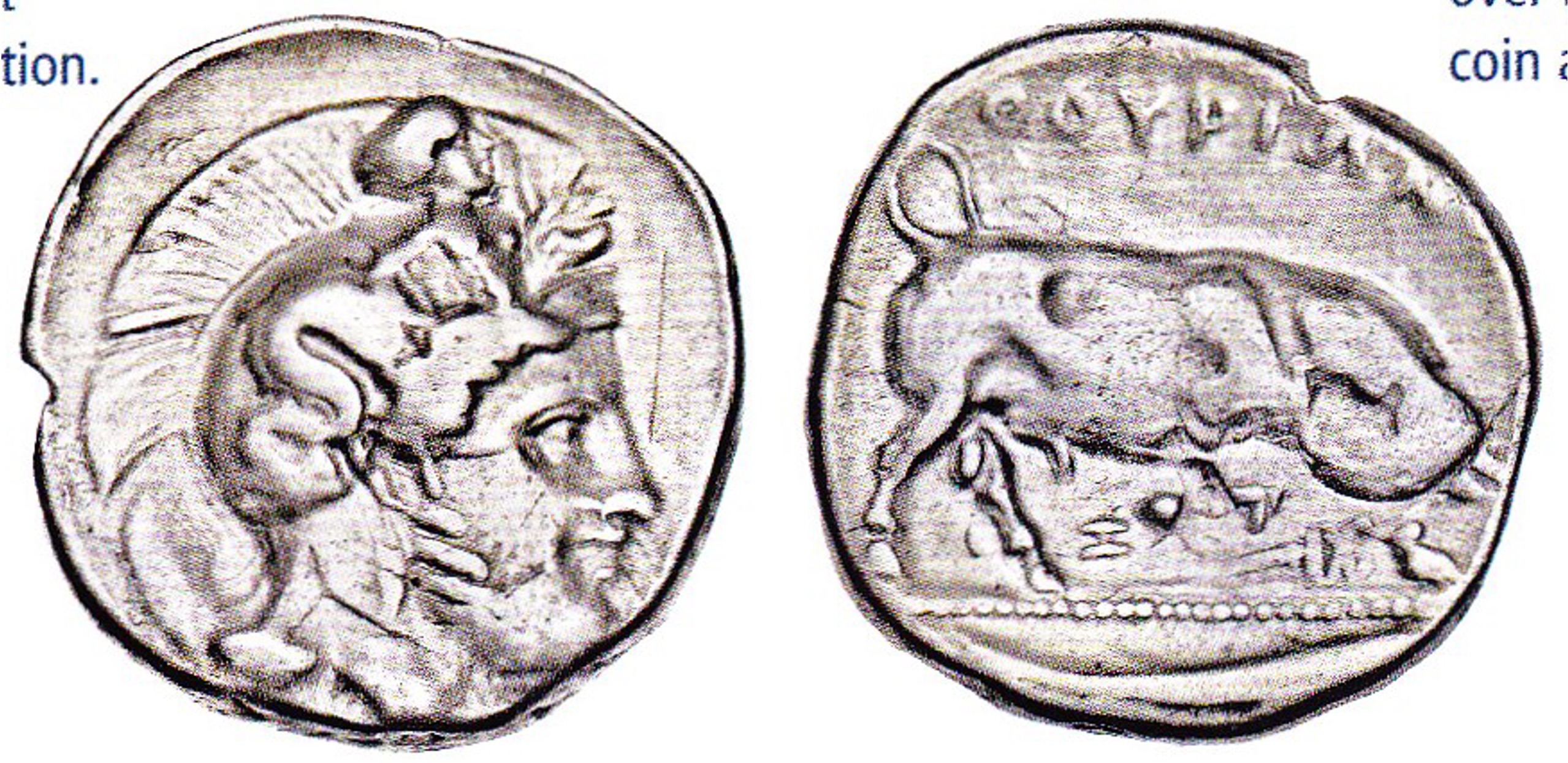400 BCE - 350 BCE | ΘΟΥΡΙΩΝ
Overstriking coin
SO 1315 - Thurium over Leucas.jpg
Overstruck variety
Leukas kerykeion.jpeg
[1]
1315 Corinth (drawing).jpg
Description
| ObverseInscription or printing placed on the obverse.:
|
Head of Athena right, wearing crested Attic helmet decorated with Skylla.
|
ReverseInscription or printing placed on the reverse.:
|
ΘΟΥΡΙΩΝ (Greek) Bull charging right. Below, Z. In exergue, fish right.
|
Mint and issuing power
| MintIdentifies the place of manufacture or issue of a numismatic object.:
|
Thurium
|
Ancient regionAncient region.
|
Lucania
|
Modern countryModern country: Italy
|
AuthorityIdentifies the issuing power. The authority can be "pretended" when the name or the portrait of X is on the coin but he/she was not the issuing power. It can also be "uncertain" when there is no mention of X on the coin but he/she was the issuing power according to the historical sources:
|
|
Chronology
| FromIdentifies the initial date in a range assigned in a numismatic context. 400 BCE toIdentifies the final date in a range assigned in a numismatic context.. 350 BCE
|
Classical 480-323 BC  periodTime period of the numismatic object. periodTime period of the numismatic object.
|
Physical description
MetalThe physical material (usually metal) from which an object is made.: Silver 
|
WeightWeight of the numismatic object (in grams). in grams: 7.777.77 g <br />7,770 mg <br />
|
DenominationTerm indicating the value of a numismatic object. Examples: tetradrachm, chalkous, denarius.: nomos
|
AxisDescribes the directional relationship between the obverse and reverse of a numismatic object.: 22 mm <br />0.2 cm <br />
|
|
|
StandardStandard.: Achaian
|
References
Description
| ObverseInscription or printing placed on the obverse.:
|
Pegasus flying right (visible on obverse: portions of wing and line of back visible on face and neck guard).
|
ReverseInscription or printing placed on the reverse.:
|
Head of Athena right, wearing Corinthian helmet. Behind, Λ and kerykeion (visible on reverse: back of helmet, neck guard, Λ, kerykeion).
|
Mint and issuing power
| MintIdentifies the place of manufacture or issue of a numismatic object. ᵖ:
|
Leucas
|
Ancient regionAncient region. ᵖ
|
Acarnania
|
Modern countryModern country: Greece
|
AuthorityIdentifies the authority in whose name (explicitly or implicitly) a numismatic object was issued. ᵖ:
|
|
Chronology
| FromIdentifies the initial date in a range assigned in a numismatic context. 360 BCE toIdentifies the final date in a range assigned in a numismatic context.. 300 BCE
|
Classical 480-323 BC  periodTime period of the numismatic object. periodTime period of the numismatic object.
|
Physical description
| DenominationTerm indicating the value of a numismatic object. Examples: tetradrachm, chalkous, denarius. ᵖ:
|
stater 
|
|
|
References
References
- ^ Macdonald, David (2009), Overstruck Greek coins: studies in Greek chronology and monetary theory, Whitman Publishing, Atlanta.
- ^ Rutter N. Keith et alii (eds.) (2001), Historia Numorum Italy, London, xvi, 223 p., 43 pl.
- ^ Hoover, Oliver D. (2018), The Handbook of Greek Coinage Series, Volume 1. Handbook of Coins of Italy and Magna Graecia, Sixth to First Centuries BC., Lancaster-London, 2018, lxi, 527 pages, 23 cm
- ^ Calciati, Romolo (1990), Pegasi, Mortara, Edizioni I.P..
- ^ Carter, Candace (1993), "The staters of Leucas : a numismatic and historical study", in: La monetazione corinzia in Occidente : atti del IX Convegno del Centro internazionale di studi numismatici, Napoli, 27-28 ottobre 1986, p. 35-42.
 Traces of the overstruck variety
Traces of the overstruck variety

